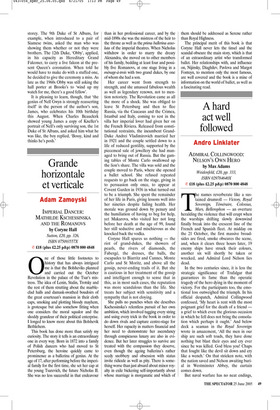Grande horizontale et verticale
Adam Zamoyski
IMPERIAL DANCER: MATHILDE KSCHESSINSKA AND THE ROMANOVS by Coryne Hall Sutton, £20, pp. 326, ISBN 075093557X ✆ £18 (plus £2.25 p&p) 0870 800 4848 One of those little footnotes to history that has always intrigued me is that the Bolsheviks planned and carried out the October Revolution in the palace of the Tsar’s mistress. The idea of Lenin, Stalin, Trotsky and the rest of them strutting about the marbleclad halls and damask-swathed boudoirs of the great courtesan’s mansion in their cloth caps, smoking and plotting bloody mayhem, is grotesque but also somehow fitting when one considers the moral squalor and the shoddy grandeur of their political enterprise. I longed to know more about this Bolshevik Bethlehem.
This book has done more than satisfy my curiosity. The story it tells is an extraordinary one in every way. Born in 1872 into a family of Polish dancers who had moved to St Petersburg, the heroine quickly came to prominence as a ballerina of genius. At the age of 17, after performing before the imperial family for the first time, she set her cap at the young Tsarevich, the future Nicholas II. She was no less successful in that endeavour than in her professional career, and by the mid-1890s she was the mistress of the heir to the throne as well as the prima ballerina assoluta of the imperial theatres. When Nicholas withdrew in order to marry the dreary Alexandra, she moved on to other members of his family, bedding at least four and possibly five Romanovs, at one stage living in a ménage-à-trois with two grand dukes, by one of whom she had a son.
Her career went from strength to strength, and she amassed fabulous wealth as well as legendary renown, not to mention notoriety. The Revolution came as all the more of a shock. She was obliged to leave St Petersburg and then to flee Russia, via the Caucasus and the Crimea, Istanbul and Italy, coming to rest in the villa her imperial lover had given her on the French Riviera. Released from constitutional restraints, the incumbent GrandDuke Andrei Vladimirovich married her in 1921 and the couple settled down to a life of reduced gentility, supported by the piecemeal sale of jewellery she had managed to bring out of Russia. But the gaming tables of Monte Carlo swallowed up the lion’s share. The villa was sold and the couple moved to Paris, where she opened a ballet school. She refused repeated requests to go back on the stage, giving in to persuasion only once, to appear at Covent Garden in 1936 in what turned out to be a triumph. She spent the remainder of her life in Paris, giving lessons well into her nineties despite failing health. Her morale was ground down by penury and the humiliation of having to beg for help, yet Makarova, who visited her not long before her death at the age of 99, found her still seductive and mischievous as she knocked back the vodka.
Coryne Hall spares us nothing — the riot of grand-dukes, the showers of pearls, the rivers of diamonds, the Fabergé, the dresses, the balls, the escapades to Biarritz and Cannes, Monte Carlo and St Moritz, and above all the gossip, never-ending trails of it. But she is cautious in her treatment of the gossip and intelligent enough to sense that in this, as in most such cases, the reputation was more scandalous than the life. She treats her subject with sensitivity and a sympathy that is not cloying.
She pulls no punches when she describes Kschessinska’s relentless pursuit of her own ambition, which involved tugging every string and using every trick in the book in order to do down rivals and capture centre-stage for herself. Her rapacity in matters financial and her need to demonstrate her ascendancy through conspicuous luxury are also in evidence. But her later struggles to survive are treated with the compassion they deserve, even though the ageing ballerina’s rather seedy snobbery and obsession with status invite ridicule as well as pity. There is something worse than just absurd about minor royalty in exile bickering self-importantly about whose marriage is morganatic and which of them should be addressed as Serene rather than Royal Highness.
The principal merit of this book is that Coryne Hall never lets the tinsel and the scandal obscure the main story, which is that of an extraordinary artist who transformed ballet. Her relationships with, and influence on, Nijinsky, Diaghilev, Pavlova and Margot Fonteyn, to mention only the most famous, are well covered and the book is a mine of information on the world of ballet, as well as a fascinating read.


































































 Previous page
Previous page